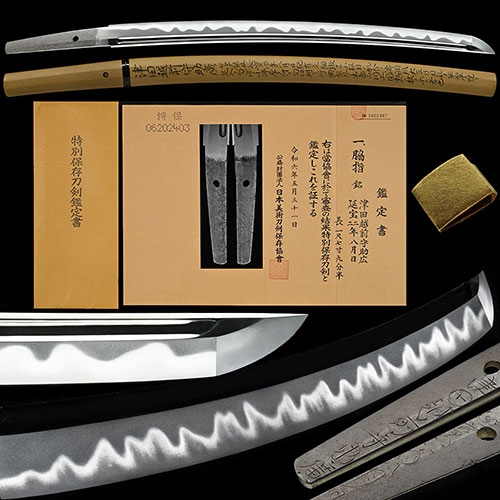
助広 脇差Sukehiro Wakizashi
No.043717脇差 津田越前守助広 延宝二二年八月日 丸津田 精良な地鉄に沸匂深い究極の濤瀾乱れ地刃冴え渡る最高傑作 一尺八分Wakizashi Tsuda Echizennokami Sukehiro August 22nd year of Enpo period, Marutsuda Clear Jigane and Deep Nie Nioi, The ultimate Toran-Midare, and a masterpiece, Jiba is clear.
ご成約Sold
- 銘表Mei-Omote
- 津田越前守助広 津田越前守助広 Tsuda Echizennokami Sukehiro
- 裏銘Ura-mei
- 延宝二二年八月日延宝二二年八月日 August 22nd year of Enpo period
- 登録証Registration
- 兵庫県 Hyogo 令和5年3月17日 3/17/5(Reiwa)
- 時代Period
- 延宝四年 357年前Enpo 4th year, 357 years ago
- 法量Size
-
刃長 54.4cm (一尺八分) 反り 1.0cm
元幅 3.26cm 先幅 2.32cm 元重 0.81cm 鎬厚 0.81cm 先重 0.58cm 鋒長 3.45cm 茎長 15.0cm 重量 638gHachou 54.4cm (一尺八分) Sori 1.0cm
Moto-Haba 3.26cm Saki-Haba 2.32cm Moto-Kasane 0.81cm Shinogi-Thikess 0.81cm Saki-Kasane 0.58cm Kissaki-Chou 3.45cm Nakago-Chou 15.0cm Weight 638g - 国Country
- 摂津Settsu
- 姿Shape
- 鎬造、庵棟、身幅広く、反りやや浅く、中鋒。Shinogidukuri, Iorimune, Wide Mihaba, Slightly shallow Sori, Chu-Kissaki.
- 鍛Kitae
- 小板目肌つみ、小杢目肌交じり、地沸微塵に厚くつき、地景細かく入り、鉄明るく冴える。Small-Itamehada-tsumi, Jinie entered fine and thick, Chikei entered finely, Iron is bright and clear.
- 刃文Hamon
- 焼き幅広い大互の目乱れに、足・葉太く入り、小沸深くよくつき、匂深く、匂口明るく冴える。Wide Yakihaba with Oh-Gunome-Midare, There are thick Ashi and You, Small-Nie entered deeply well, Deep Nioi, Nioikuchi is bright and clear.
- 帽子Boushi
- 直ぐに小丸、やや深く返る。Suguni-Komaru, Slightly deep Return(Fukaku-Kaeru)
- 茎Nakago
- 生ぶ、先栗尻、鑢目筋違、目釘孔一。Ubu, Sakikurijiri, Yasurimesujikai, Mekugiana is one(1)
- ハバキHabaki
- 金着一重。Single Kinkise (Wearing a single layer of gold.)
- 説明Drscription
- 津田越前守助廣は、長曽弥虎徹、井上真改と並び称される新刀を代表する名工で、最上作に名を連ねており、殊に刃の明るさは新刀屈指といわれている。二代助広は、通称を甚之丞、寛永十四年(1637年)に摂州打出村(現兵庫県芦屋市)で生まれ、初代助廣門に入り、後に養子となっている。明暦三年(1657年)に越前守を受領、寛文七年(1667年)より大坂城代青山因幡守宗俊に召し抱えられ、天和二年(1682年)に四十六歳で没している。作風は、初めは石堂風の丁子刃であるが、次いで互の目から、大互の目となり、遂には濤瀾刃へと進歩を遂げる。この刀は、身幅広い堂々とした姿を呈す延宝四年の年紀が入る助広三十八歳の作である。地沸微塵に厚くつき、地景細かく入る明るく冴えた精緻な美しい地鉄に、鎬まで迫る焼き幅大きな互の目が華やかに乱れ、足・葉太く入り、地刃冴え渡り、沸匂深い究極の濤瀾乱れを焼く。僅かに生刃が残るほど頗る健全で、丸津田銘、助広円熟期の最高傑作である。TsudaEchizennokami Sukehiro is a master craftsman who represents the new swords along with Yakotetsu Nagaso and Shinkai Inoue. The second Sukehiro, commonly known as Jinnojo, was born in 1637 in Uchide-mura, Setshu (now Ashiya City, Hyogo Prefecture), became the first Sukehiro, and was later adopted. In the 3rd year of Meireki (1657), he received the position of Echizen no kami, and in 1667, he was employed by Aoyama Inaba no Kami Munetoshi, the lord of the Osaka Castle, and died in the 2nd year of Tenwa (1682) at the age of 46. ing. At first, the style was Ishido-style clove blade, but then it changed from Gonomome to Ogonomome, and finally progressed to Toranba.
This sword, with its broad and imposing wide mihaba, was made in the fourth year of the Enpo Era, when Sukenoh was thirty-eight years old.
Jinie entered fine and thick, Chikei entered finely with bright and clear beautiful Jigane, The large Yakihaba Gunome, approaching Shinogi, is gorgeously Midare, There are thick Ashi and You, Jiba is clear, Deep Nie-Nioi and the ultimate Toran-Midare. It's a very good Kenzen with just a hint of Ubu-ba remaining. It's a masterpiece from Marutsuda Mei, Sukehiro's finest work.


